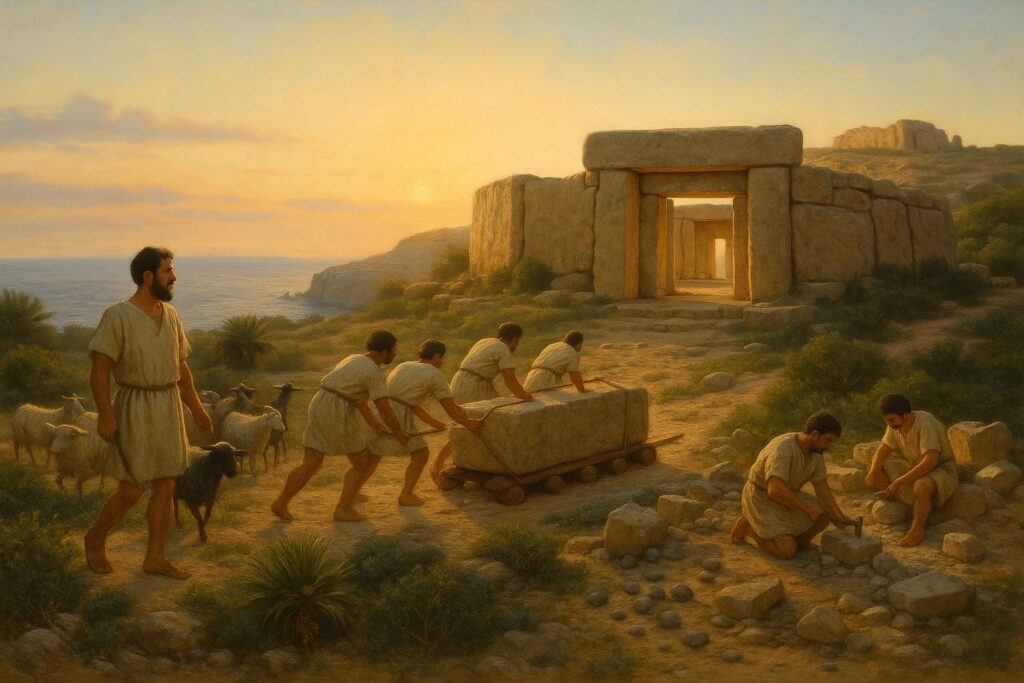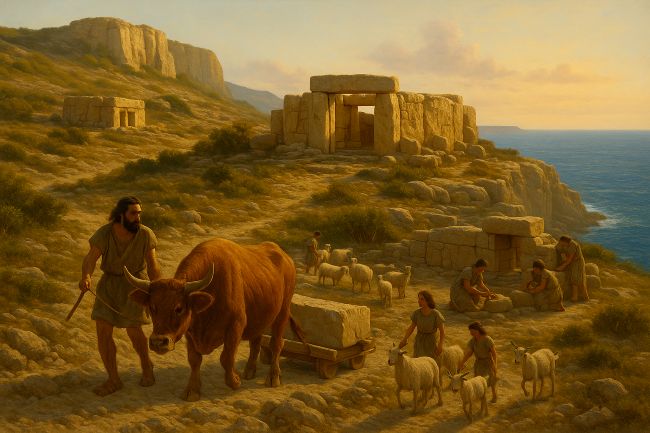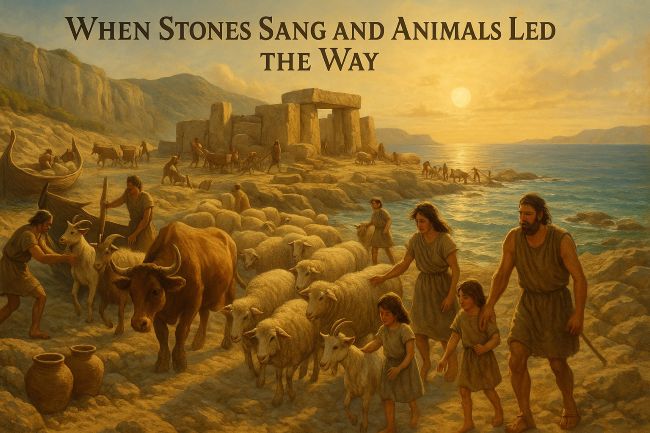| Malta Short Let: Cozy Stay in Gzira | |
|
Sliema Area Modern Designer Finished 2 Bedrooms + Games Room. First floor with Maltese Balcony Large back Terrace with swinging sofa Fully Airconditioned + Full Kitchen 3 TVs, including 65” with backlight. |
 |
|
Book Now: Google Travel | Direct (Cheapest) | Booking.com | Airbnb |
|
When Stones Sang and Animals Led the Way
Eight thousand years ago, long before smartphones cluttered our pockets or cars clogged our roads, a group of determined families stepped onto Malta’s rocky coastline. In their boats: sheep bleating against the Mediterranean wind, goats already eyeing the limestone cliffs, cattle shifting restlessly after days at sea. This wasn’t just another migration—it was the first chapter of a civilization that would leave us some of humanity’s most stunning monuments.

Around 6000 BC, these Neolithic pioneers laid the foundations for a culture that would reach extraordinary heights during the Temple Period (3600-2500 BC), creating Ġgantija, Ħaġar Qim, and Mnajdra—monuments that crowned their growing mastery of the land. These enigmatic temples of Malta would become some of humanity’s most remarkable achievements.
Welcome to prehistoric Malta, where ordinary people did extraordinary things, and where every stone temple tells a story of determination and unbreakable human spirit.
More Than Farmers—They Were Architects of Dreams
When you visit the temples of Ġgantija or Mnajdra today, you’re looking at more than ancient stones. These are monuments to people who shared your basic human concerns—worrying about their children, mourning their dead, celebrating good harvests, gazing up at the same constellations we see tonight.
But here’s what takes your breath away: they built these incredible temples without a single modern tool. No cranes. No bulldozers. No power drills. Just human hands, human hearts, and an unshakeable belief that something beautiful was worth the backbreaking work.
The construction scenes must have been remarkable—dozens of families collaborating under the Mediterranean sun, somehow moving limestone blocks weighing several tons. Children played nearby while their parents shaped soft Globigerina limestone into intricate bowls and figurines. Each massive Coralline limestone slab that settled into place represented hours of collective effort and shared determination.
These weren’t just construction projects. They were acts of devotion, built by people who understood that creating something lasting required everything they had to give.
The Animal Partners Who Made It All Possible
The real drama of this story unfolds in the relationship between these ancient Maltese and their animals. This wasn’t simple farming—it was partnership, survival, and genuine interdependence.
Sheep were the cornerstone of prehistoric Malta, making up over 80% of the livestock according to archaeological evidence. These woolly partners provided milk that was transformed into cheese and yogurt in beautiful pottery vessels. Their wool became clothing for Mediterranean winters, and young lambs provided meat—but with careful timing. The Maltese were master shepherds, slaughtering lambs at around four months old in spring to maximize the rich ewe’s milk for cheese-making while providing rennet for the process. When summer dried the grasslands, they fed their flocks leaves from oak and lentisk trees, sustaining them through the harshest months.
Goats were the hardy survivors, munching through scrubland that other animals couldn’t handle. Tough and independent, they thrived on Malta’s rugged terrain where sheep struggled. Their milk enriched family diets, and their ability to exploit marginal land made them invaluable insurance against hard times.
Cattle were the powerhouses—plowing fields that fed communities and quite possibly helping to haul the massive temple stones. At Kordin III, archaeologists found a stone trough that could accommodate seven feeding animals, hinting at temple-managed herds, carefully fattened for sacred feasts. The trust between farmer and ox, working together season after season, was fundamental to survival.
Pigs were the feast-makers, raised primarily for meat and slaughtered young to provide protein for special occasions. Their bones, found carefully arranged in temple contexts, played important roles in the ritual meals that strengthened community bonds.
Beyond their herds, the Maltese also hunted shearwaters—seabirds caught in cliff nests during their nocturnal visits. Some shearwater bones were shaped into polished tools, showing how every resource was utilized. Curiously, fish were rarely eaten despite the sea’s abundance, with only isolated finds like a single grouper bone, perhaps reflecting cultural preferences that kept these islanders focused on their trusted livestock.

When Animals Met the Sacred
The story becomes even more compelling when you consider how these animals entered the spiritual life of Maltese culture.
Walk through the temples today and you’ll see them everywhere—stone friezes showing processions of goats, bull carvings on massive orthostats, carefully placed animal bones on temple altars. At Tarxien, archaeologists found tethering stones near temple entrances, suggesting that live animals were brought to these sacred spaces. Enormous stone vessels and circular fire pits indicate large-scale food preparation and communal feasting, where the meat from sacrificed animals was shared among the community.
These weren’t brutal rituals, but expressions of gratitude and community bonding. Families bringing their finest animals to the temple during festivals tied to agricultural cycles shared in feasts that reinforced social connections across generations. The temples, carefully oriented toward solar and celestial events, synchronized these gatherings with the rhythms of farming life, creating a calendar of shared celebration and survival.
This spiritual connection between humans and animals also extended to their underground world—visit the remarkable Hal Saflieni Hypogeum to see how these beliefs evolved in Malta’s most mysterious subterranean sanctuary.
The Genius of Making Do
The most striking aspect of these ancient Maltese is how they turned severe limitations into innovations. Malta is a small island with challenging resources, but these people made every material count—and adapted when their environment changed around them.
The Maltese faced a restless landscape where soils, once rich and organic, steadily eroded away. Human activity and natural processes stripped upland areas, depositing sediment up to 14 meters deep in valleys like Salina Bay. Rather than surrender to this loss, they fought back ingeniously. Archaeological evidence suggests they dragged precious soil back to their fields, perhaps hauling it on wooden sledges, and by the Bronze Age had developed rudimentary terrace systems to hold the earth in place.
Water presented another challenge in Malta’s increasingly dry climate, but they solved this too. Springs fed by underground aquifers, like the reliable source beneath Ġgantija temple, provided year-round water for crops and animals even as the landscape grew more arid. These ancient water solutions would inspire management systems used throughout Malta’s history.
They mixed local Blue Clay with shells and grit to create pottery that lasted millennia—pottery that connects us to this ancient civilization in remarkable ways. They learned that soft limestone could be carved into delicate art while hard limestone made perfect building blocks. They discovered that mixing clay with crushed limestone created “torba”—a waterproof flooring material so effective that Maltese builders used it until recently.
When they needed tools, they imported precious obsidian from volcanic islands and worked every tiny fragment until nothing was wasted. When resources grew scarce, they didn’t just survive—they innovated.
A Story That Speaks to Us Today
This ancient story resonates today because it shows humans as eternal problem-solvers. These Maltese farmers dealt with climate change—yes, even then—as their soils became drier and less fertile. They managed resource scarcity, social pressures, and the endless challenge of feeding growing communities.
Yet they didn’t surrender. They adapted, innovated, and came together. When soil eroded, they developed terracing systems. When resources were scarce, they managed their animals more strategically. When times were tough, they gathered in their magnificent temples and strengthened the bonds that held them together.
Like the Maltese communities uniting to save their soils and sustain their herds, today’s world shows that shared purpose and collective innovation can overcome even the greatest environmental challenges.
For the Traveler’s Heart
When you visit Malta, these temples offer more than photo opportunities. They’re direct connections to human ingenuity and determination.
Stand in the curved chambers of Ħaġar Qim at sunset and listen for the echo of ancient voices. Touch the megalithic stones of Ġgantija and feel the hands that shaped them. Walk through Tarxien and picture the festivals where entire communities gathered, sharing food, stories, and hope.
These places aren’t just about the past—they’re about the enduring human spirit that connects us all. To truly understand Malta’s fascinating history, you need to start with these remarkable temple builders who set the foundation for everything that followed.
The Echo of Ancient Hearts
The people of prehistoric Malta built more than temples. They built a way of life that honored both the practical and the sacred, that valued both individual effort and community bonds, that understood that survival required not just hard work but also beauty, ritual, and meaning.
Their sheep still graze Maltese hillsides. Their stone temples still catch the Mediterranean light. Their story still whispers that ordinary people, working together with determination and ingenuity, can create something extraordinary that endures across millennia.
In a world that often feels fragmented, perhaps we need their reminder: that our ancestors faced uncertainty and environmental challenges too, but they faced them together. They built not just for themselves, but for us—their distant descendants who stand amazed before their work and remember that we too are capable of extraordinary things when we combine human creativity with collective purpose.








